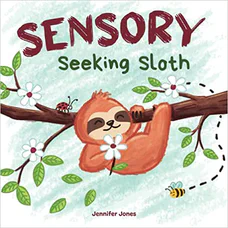Sensory Seeking Sloth
Written and illustrated by Jennifer Jones
35 pages
•
Published 2021 (Independently Published)

Recommended Age Range: Preschool through 3rd grade.
Publisher's Summary:
The solution-based book that helps children understand Sensory Processing Disorder (SPD) and presents a sensory diet that offers tools and resources a child can use.

Dr. Annie's Takeaways
Recommended for: This book is a relatively fun way to introduce the idea of increasing a child’s sensory input throughout the day to meet their sensory needs. This can be a helpful intervention for some children with autism, ADHD, anxiety, and body-focused repetitive behaviors (e.g., skin-picking and hair-pulling). It introduces the concept of sensory seeking and provides many concrete examples a child can try out (e.g., jumping on a trampoline, eating something crunchy, playing with a fidget toy). School psychologists and counselors, as well as OTs, may particularly find this book useful when discussing interventions for kids to try out.
Would a child like it? This book isn’t just terribly engaging, but it’s useful, and the illustrations are quite cute. It’s more of a tool than a story.
Evidence-Based Practices:
Psychoeducation
Tone: Straightforward, informative
Story Quality: The text of this book is informative but not particularly engaging. It is a useful book, though, and it is written in a clear, accessible manner.
Illustrations: The illustrations make this book palatable to a kid. They’re cute and fun. Or maybe I just love a good sloth.
Representation: This book is written in the first person, and the illustrations picture a sloth. There are no gender indicators in the text or illustrations. The sloth “crave[s] sensations” in every sensory category (e.g., touch, taste, sight) and shares that a “sensory diet” (i.e., intentionally increasing sensory stimulation) helps them to feel better. Although the diagnosis “Sensory Processing Disorder” is used in the publisher’s summary, no diagnostic labels are used in the story.
Psychological Practices: This book introduces the concept of “sensory seeking” and provides healthy and safe suggestions for increasing a child’s sensory input throughout the day. Suggestions include: swinging at the park, sitting on a wobble chair, playing with a sensory bin, jumping on a trampoline, wrapping oneself in a blanket burrito, listening to music, looking at colorful lights, and eating something crunchy. These interventions can be helpful for children with a large range of diagnoses, including autism, ADHD, and body-focused repetitive behaviors (e.g., skin-picking). counter_practices: Sensory diets are not really considered an evidence-based treatment (yet, at least). However, in my experience–as well as many families’–there are kids that benefit from increased sensory input, and many psychologists recommend these techniques.
Buy This Book:
Amazon
